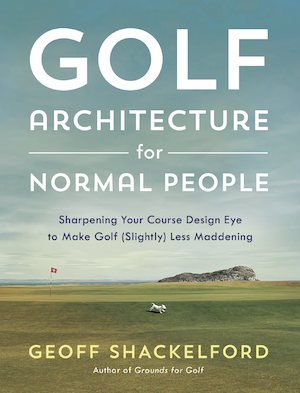When you come to think of it that is the secret of most of the great holes all over the world. They all have some kind of a twist. C.B. MACDONALD
Player And Horschel Try Different Eras Of Clubs
/New PGA President: Don't Mess With Amateur Distance!
/Larry Fine on the PGA of America's outreach efforts and its new President, Ted Bishop, not supporting any kind of distance rollback that might impact the average player.
"If you do anything that's going to cause the rank and file amateur player to not hit the ball as far, there's no way you're going to enhance their enjoyment of the game," PGA President Ted Bishop told reporters on Tuesday.
And...
"I'm not so sure that's the greater issue we have to deal with," Bishop told Reuters. "This game is a hard game and anything we do to make the golf course play longer, play more difficult, is certainly going to deter from the enjoyment of the game for the average player."
Pssst....Ted, it's all taking longer and is more difficult because we're after this distance thing like a dog chasing its tail.
Bishop has already spoken out against the USGA/R&A ban on anchoring.
False Alarm: Adam Back To Anchoring For Aus Open
/Freakonomics Guy: Forget Anchoring, Distance Is Golf's Real Problem
/Buried Lede In The Anchoring Ban Announcement?
/Ron Sirak, writing about the announcment of a ban on anchoring putters against the torso:
So for those currently anchoring the long putter, the announcement today created their own version of the Mayan calendar, which some say predicts the word will end Dec. 21 of this year, which is bad news for those currently leading their fantasy football leagues.
And I say there is a 100 percent chance that this ban is not an end but a means to an end, a beginning salvo in a battle by the USGA and the R&A to push back against some of the ways the game has changed in recent years.
They used the opportunity to repeat some of the strongest words on distance to ever come out of St. Andrews, Far Hills or their new de facto headquarters in an Orlando conference room.
But then he moved to the distance topic that has created many more problems than anchored putters:
As far as the distance issue is concerned, clearly that is very germane to the future of the game.
Ok, right there. That alone is a big statement from Mr. Dawson. There's more...
It affects size of golf course, amount of land use, cost of play, and there can be no doubt at all that this distance issue has to be at the forefront of our minds at all times.
You'll recall the R&A and the USGA did issue a joint statement of principle ten years ago now saying that if distances crept up further, we would take action. Distances have actually plateaued since then.
So he reverted to old habits there briefly. But then...
But I think the issues that surround the sustainability issue are coming more and more into play when we consider distance, and both the R&A and the USGA have research projects that are ongoing in order to make sure we are ready to address this at an appropriate time.
The fact that we have chosen to do something about anchored strokes that is a completely separate matter and it would be a mistake to feel that because we have done something about one that we don't care about the other.
And the USGA's Mike Davis then chimed in:
Just to add to that, Peter mentioned [2002], the joint statement of principles, I can assure everybody, that the R&A and USGA have been quite busy on these research projects the last ten years. And looking forward, we are very concerned about the long‑term health of the game, the sustainability of the game. We are concerned about water usage. We are concerned about the cost of the game; time, as Peter mentioned.
So this is something that we are taking very seriously, and certainly we are looking, also, at distance. We want to quantify if one day there was a need to reduce distance, and we are not suggesting today; that we feel that it's our duty, that it's part of our mission to look at the future of the game.
We want to understand what reduced distance might mean; how much matter would it save? How much cost would it save? For those courses that haven't been built yet, how much less land would it mean? That's important to the future of the game. We have 33,0000 golf courses in the world right now and we need to protect them. But furthermore, we need to protect those courses that haven't been built yet.
It sure sounds like they are preparing to present data explaining what a reduced footprint would look like economically. Most of us know if they do that, combined with some shrewd forecasting on future water costs from the USGA Green Section, and their case for some sort of revised overall distance standard may just be easier to make than the anchoring case they presented Wednesday.
WSJ: Anchoring "Decision" To Come Wednesday
/"Is Augusta National doing the right thing having events that qualify 14 year olds into the event?"
/That's the question Steve Elkington posed on Twitter and after reading your many observations on the original post about Tianlang Guan's stunning Asia Pacific Amateur win, I think it's a question worth pondering.
And not to take away from Guan's stellar play or that of the kids (Zhang, Hossler) who contended at this year's U.S. Open, but maybe the broader questions should be: what is allowing people to play the game so much better at a younger age and is that a good thing?
Either way, Guan is setting lofty goals for himself!

 **Steve Elkington adds this cartoon to memoralize the historic moment.
**Steve Elkington adds this cartoon to memoralize the historic moment.
Webb Still Hasn't Heard Sound Reason For Anchoring Ban
/From an unbylined AP story quoting Webb Simpson at the Grand Slam of Golf, and while the language wasn't perfect, he seems to be suggesting that banning anchoring of the putter will be more problematic if it's the USGA doing the banning instead of the PGA Tour. Not that Commissioner No-Controversy would ever do something to protect the game.
"If the USGA bans it, I think it's going to be a whole other ballgame if the PGA Tour bans it," Simpson said.
"It's going to be tough if they do ban it. It's going to be tough for a lot of people. Not players, I think it's going to be tough for the committees to really have their stance on it. If you look at the facts, last year there was no one in the top 20 of strokes gained category that anchored a putter."
"So the argument of, 'It's an advantage', you have to throw that out there," he said. "There's a bunch of arguments going around but I haven't heard a good one yet."
 And he continued to point out a bigger change in the game and he continues to be correct.
And he continued to point out a bigger change in the game and he continues to be correct.
"We all know that the R&A and USGA love to keep golf as original as possible," he said. "But I think with the changes in the grooves, the golf balls, the drivers — you've got a little persimmon head 20 years ago the size of a fist, and now a titanium head 460 cc. In 1980, the long drive guy was hitting it 285, and now if you hit it 285, you're one of the shortest guys on the Tour. To me, it's a bigger change to go from that size head to what we play now than the putter."
"153 Golf Organisations unite to focus on sustainability as a core priority"
/The International Golf Federation that spearheaded golf's return to the Olympics is broadening its scope by issuing a statement today announcing sustainability as its "core priority." You can read the statement in PDF form here.
"The future will present many challenged but the IGF and its member organizations are working to ensure that many more generations will enjoy golf and the facilities on which it is played."
A couple of screen grabs of the fine print:

We were doing so well until the last jargon dump of an item. Go on...

It's pretty exciting to read this kind of focus on the future and desire to shrink the footprint of golf courses. But this is all utter nonsense if the distance the ball travels is not reduced via some form of regulation. Otherwise, the game will continue to spend money on new tees, more rough, faster greens and bigger properties.
**There was also apparently a USGA press release on this but I didn't get it. Cybergolf thankfully posted it.
The pertinent quotes...
"Sustainable management practices are critically important to the future of the game and need to be encouraged throughout the world," said USGA President Glen D. Nager.
"Here in the United States, sustainability principles have been embraced by the golf community for some time, but we can still do even more, especially in promoting solutions-based planning and management strategies. "Environmental and economic sustainability are central to the USGA's mission and are primary components of our long-term commitment to the game," Nager continued. "We have invested significant time and resources over many years to ensure that we are basing decisions and recommendations on sound scientific and economic principles that will foster the future health of the game."
"The future ramifications of a more proactive approach to sustainability will be far-reaching," said USGA Executive Director Mike Davis. "From the golf course operator who can more effectively allocate his maintenance budget, to the player who benefits from firm course conditions, every part of the game can benefit from this global industry-wide commitment."
Jack Thinks The USGA Will Be Rolling Back The Golf Ball "In the not-too-distant future."
/From his ESPN 980 radio interview transcript when asked about the ball and the size of the driver head.
“I think both. I think it all starts with the golf ball. I think the USGA will probably end up doing that in the not-too-distant future. (Host: How about a tour ball?) More for the game of golf. The game of golf has three problems. It’s too hard, it’s too expensive and it takes too long. If they dialed the golf ball back it would reduce all those costs. The costs of maintaining the golf course, the cost of land and all those things would be dialed back and as an added benefit there’s only one golf course in this country that is not obsolete to the pros and that’s Augusta National, they’re the only people that have enough money to build the golf course and do the things they needed to do. Every time they have an event what do they do? Build new tees, new bunkers and do everything. It doesn’t make any sense. The simplest thing to do is fix the golf ball.”












